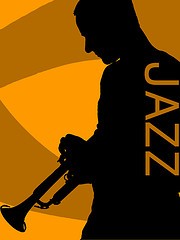3 Of The Most Useful Scales To Play Over Major Chords
 When most players first start jamming over major chords they’ll usually turn to licks and ideas built from the major scale.
When most players first start jamming over major chords they’ll usually turn to licks and ideas built from the major scale.
This can create a nice inside sound but often times the lines can get predictable and somewhat boring.
We don’t want to be boring and predictable right? 🙂
Fortunately, there is a solution to spice up your soloing over major chords. So, in today’s free jazz lesson we’re going to explore a couple other scales (modes) you can use over major chords. In case you missed it, here’s our comprehensive guide to exploring jazz piano scales.
These scales will provide some additional note choices that will ultimately give you more ability to express yourself (video, lesson, jam track, and notation below)
Bonus: Here is a free jam track that you can use to practice these different type of major scales/modes over. The track features real samples of upright bass, drums, and percussion.
It is over 4 minutes and gives you lots of time to stretch out, learn, and jam. Enjoy!
The Piano Scales Notated
Here is the first scale you can play over major chords. I’ve written them as key of C scales but you can and should tranpose this scale to any key that you see a major chord in.
If you need more ideas about how to creatively practice scales and technique make sure you also check out this jazz technique article
(Also watch the video above to really learn how to jam with these different scales)
1. Major Scale
(Scale Degrees 1, 2, 3, 4, 5, 6, 7)
 This is the most fundamental and basic of all the popular scales. You’ll see a lot of jazz theory books say the 4th scale degree of a major scale is considered an avoid note in this scale.
This is the most fundamental and basic of all the popular scales. You’ll see a lot of jazz theory books say the 4th scale degree of a major scale is considered an avoid note in this scale.
This isn’t always true though as there many examples of jazz musicians playing the 4th scale degree over a major chord.
For example, this turnaround lick features this concept and so does this Charlie Parker lick .
I think the thing to keep in mind is that you don’t necessarily want to sit on the note. It needs to be resolved.
Now, that we’ve gone over the basic scale are you ready for something a bit more interesting sounding now?
———————————————–
2. Lydian Scale
(Scale Degrees 1, 2, 3, #4, 5, 6, 7)
I love the lydian mode. In my opinion the #4 is one of the most beautiful notes you can play over a major chord. So, I’m partial to this scale.
It should be noted though that most of the time people will eventually resolve the #4 up to the 5th scale degree since it’s a chord tone and more of an “inside” note.
———————————————–
3.Mixolydian Scale
(Scale Degrees 1, 2, 3, 4, 5, 6, b7)
Technically speaking this is a dominant chord scale but you can still sometimes hear this scale being played over a major chord.
It creates a bit more of a blues like sound. If you’re interested in other dominant chord scales also check out this dominant chord scale article.
Piano Scales Practice Tips
1. Remember to learn these scales in all 12 keys. You want to sound just as good in the key of Gb as you do in Ab.
Fluency in all 12 keys is a must and it’s fun to explore your instrument on a deeper level.
2. Try learning some scale sequences and patterns to apply to these popular scales. Sequences are a melodic patterns repeated but started on different pitches.
Put on the jam track above and start applying some sequences of these 3 major modes on top.
Update: There is a now a lesson on minor jazz scales too.
**********
I hope that you’ve enjoyed this free jazz lesson. These are very popular scales and can be used in so many different songs and styles of music.
Feel free to come back to this page regularly and practice using the jam track above.
If you are new here are please be sure to say hello and leave a comment below.
Also, be sure to sign up for the free jazz lessons email list. It’s quick, easy, and free. The sign up form is on the right side of the website.
